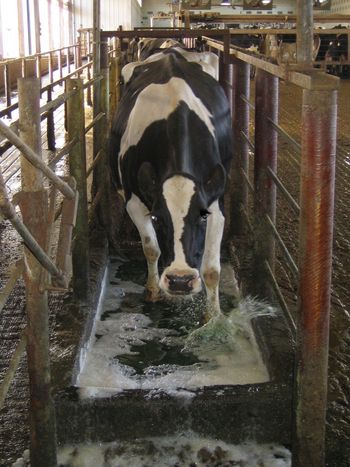Vet med scientists find better, safer treatments for hoof disease in cattle
For almost 40 years, digital dermatitis has plagued cattle throughout the world. Also called heel warts, these painful hoof lesions limit the amount of time cows can stand and feed, which can hinder animal welfare and food production. The disease can be found on almost every beef and dairy farm in North America, so it has a significant economic impact on those industries in the United States.

Hoof baths involve soaking infected hooves in solutions of copper sulfate or formaldehyde, which can be environmentally problematic or hazardous to the health of dairy workers, so alternative treatments like feed supplements and botanically derived baths are welcome.
Photo: Nigel Cook
Fortunately, researchers at the UW–Madison School of Veterinary Medicine are helping to find new ways to address the disease. Some of this work has led to the development of safer, more effective treatments. But the road to these innovative approaches began with the creation of an effective testing method.
“For digital dermatitis, we developed an experimental infection model to reproduce and treat acute digital dermatitis lesions in cattle in a standardized way and in a controlled environment,” says Dörte Döpfer, assistant professor of food animal medicine and an expert in veterinary epidemiology. This involved isolating a very small population of cattle in a laboratory setting free from other factors that can affect the natural course of the disease.
According to Döpfer, the experimental model helps improve animal welfare. Many treatment and preventive measures hit the market before being properly tested, which can be detrimental to millions of cattle. The infection model allows her research team to pre-screen products on a small-scale population before they are used in the field.
“In addition, the impact on the test cows is minimal,” says Döpfer. “As part of any study, the induced acute lesions are treated with antibiotics immediately. The pain is gone within a day, and the lesions do not become chronic. The cattle lead a perfectly healthy life afterwards.”

Dörte Döpfer
The experimental model has been used successfully in university-industry partnerships aimed at developing better ways to prevent and treat digital dermatitis. Zinpro Corporation has been collaborating with Döpfer on clinical trials since 2010. By analyzing data from those trials, she and Arturo Gomez Rivas, a research assistant at the School of Veterinary Medicine, helped assess the effectiveness of treatments that prevent digital dermatitis in pre-calving heifers.
One of these treatments is a new approach to supplementing cattle diets with trace minerals, which are nutrients like zinc that living things need in very small amounts. According to Döpfer, the study showed that treatments with feed ingredients containing these minerals can reduce the prevalence of digital dermatitis. As an added benefit, this cuts down on the need for hoof baths, which involve soaking infected hooves in solutions of copper sulfate, formaldehyde, or other chemicals.
“These are the standard preventive treatments, but they can be environmentally problematic or hazardous to the health of dairy workers, so any alternative is welcome,” says Döpfer.
Döpfer and her colleagues have partnered with another company, Laboratoire M2 of Sherbrooke, Quebec, to evaluate the effects of a safer, alternative hoof bath solution through field trial observations. Laboratory tests have shown that the company’s product, which contains botanically derived active ingredients, effectively kills and inhibits treponemes, the main bacteria that cause digital dermatitis. This work was only possible because Gomez Rivas used the experimental model in 2011 to identify the bacteria as the primary culprit.
“The hoof bath that can prevent these chronic lesions from reverting into active lesions is the hoof bath that we want.”
Dörte Döpfer
“The cause and subsequent development of digital dermatitis are complex, and the experimental model gives us a better understanding of the important role the bacteria play in the process,” says Gomez Rivas.
Field tests have shown that the botanical hoof bath also helps prevent chronic lesions, which is vitally important for controlling the disease. While acute active lesions can cause pain and lameness, they can be readily treated with topical antibiotics.
“But even after topical treatment of these active lesions, treponemes still reside deep in the skin,” says Döpfer. “This can cause chronic lesions, which have thick skin and spread rapidly. They act as reservoirs of infection, and they are precursors to new, acute lesions. The hoof bath that can prevent these chronic lesions from reverting into active lesions is the hoof bath that we want.”
Eventually, Döpfer hopes to see widespread adoption of an integrated prevention and control system for digital dermatitis. “Usually, a company provides a topical agent or hoof-bathing,” she says. “But a long-term integrated system would also include keeping detailed herd records from youngstock to heifer to cow, combatting risk factors like bad hygiene, and possibly using feed supplements as well.”


